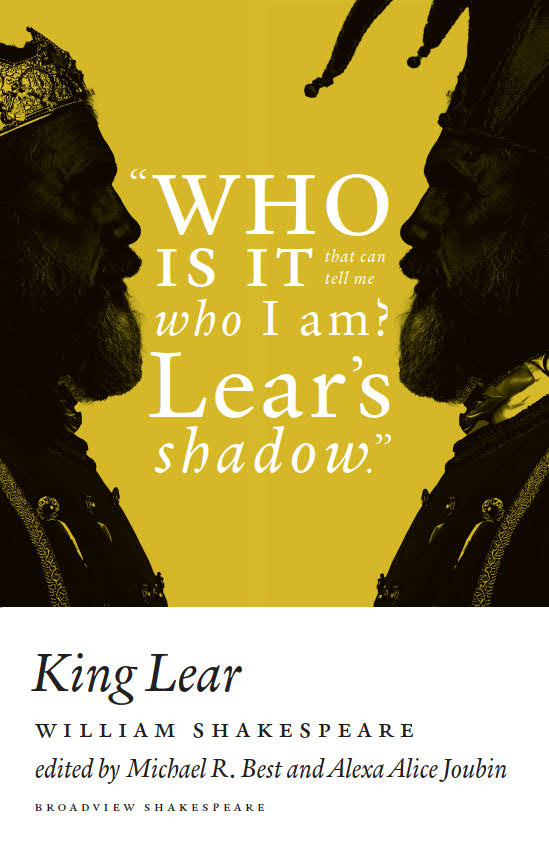Three Ways to Divide Lear’s Kingdom
In the beginning of the tragedy, Shakespeare’s King Lear famously announces his abdication and decision to pass on the duty of governance to his daughters: “Divided in three our kingdom.” The scene of regal abdication of King Lear is folkloric in origin. Structurally, when the scene begins, there are other divisions paralleling Lear’s announcement: Cordelia versus her elder sisters, and Edgar in opposition to Edmund. Lear asks his daughters to publicly confess their love for him and, by extension, their loyalty to the throne.

Is Lear’s division of his kingdom a ceremony with more symbolic than substantive meanings, a premeditated act of policy, or a public test of true love?
Kathakali King Lear interprets this scene as a ceremony. The adaptation premiered at the London Globe in 1989 and toured internationally through 1999. Kalamandalam Padmanabhan Nair performed Lear in the kathakali style. The ritualistic quality of Shakespeare’s scene matched the ritualistic origin of the temple-driven genre of kathakali which often portrays “non-worldly” characters drawn from the Indian epics. The Shakespearean motifs of betrayal and loss were fused seamlessly to classical kathakali forms of Malayalam lyrics and corresponding mudra (hand gestures). Co-produced by the French director-choreographer Annette Leday and Australian playwright David McRuvie, this adaptation treats the division of the kingdom and downfall of Lear as a cleansing ritual. The solemn ceremony does not bear much political weight. This adaptation strategy focuses on the ceremonial nature of Shakespeare’s scene, and brings it to bear on the ritualistic art form of kathakali dance drama.
Peter Brook’s 1971 film interprets the scene as a premeditated act of policy. The division-of-the-kingdom scene is dominated by close-ups of the aging monarch, framing Scofield’s Lear as a solemn statue. Scofield’s Lear speaks methodically and remains stern throughout the scene, which ends with him calmly banishing his youngest daughter. Meanwhile, Brook’s decision to cut Cordelia’s asides diminishes the weight of a potentially revelatory moment as well as Cordelia’s self-discovery. The scene sets a sinister and nihilistic tone for the entire narrative.
Similarly, Richard Eyre’s 2018 film uses the divisive politics in the tragedy as a metaphor for contemporary politics. After the UK’s 23 June 2016 referendum to leave the European Union, directors and readers have turned to King Lear as a “Brexit play”—a play about division and dispossession, with the map as its central prop in the opening scene.
Anthony Hopkins’s exiled Lear finds himself in pouring rain in a refugee camp, an unaccommodated man. The film alludes to the issue of migration and the refugee crisis in Europe. In the post-Brexit context, there is dramatic irony in Lear’s decision to cut familial and political ties with Cordelia only to see her return from France to save him from oblivion. Lear’s exile and search for refuge highlights the dilemma of contemporary UK.
Interpreting the scene as some type of test, several productions put the father-monarch and the daughters to a test of human nature. Some of the performances create a more sympathetic image of Lear by making him a jolly “fond old man” who is returning to a childlike state due to his egotistical incredulity that Cordelia could be serious. Laurence Olivier’s Lear in Michael Elliott’s televised film (1983) laughs off Cordelia’s initial response (“Nothing, my lord”) and cajoles her, in a playful manner, to be more forthcoming. Lear’s line, “Mend your speech a little, / Lest you may mar your fortunes,” is spoken with doting tenderness, as Lear’s wink at Cordelia makes his favoritism clear. In most performances the line takes on a sinister undertone, as a stern warning. The Stonehenge-like set turns the court into a temple in pre-Roman, pagan Britain. Against the mythical backdrop a clear answer emerges to Lear’s question about who loves him most: himself (Elliott).
In Belarus Free Theatre’s production of King Lear at the World Shakespeare Festival directed by Vladimir Shcherban at the London Globe in 2012, Lear becomes both the volatile, capricious monarch and the clown in the very first scene. Teasing audience expectations, the production—with a liberal sprinkling of levity—amplifies the folkloric and comedic textures of Shakespeare’s tragedy. Aleh Sidorchik’s Lear emerges hunched over, in long, white hair. He slips, but as he falls, he whisks off his wig and laughs at the audience in a “gotcha” moment. Old age—traditionally the most sacred and horrifying element of this play—is turned inside out, as Sidorchik toys with the audience’s perception of old age in his parody. The traditional prop of a map of the kingdom is nowhere to be found. Instead, in Lear’s suitcase is the soil of the land that he plans to divide: each daughter would receive a “piece” of the land. To the tune of piano and accordion, Goneril and Regan take turns singing and dancing comically for Lear to express their love and devotion.

Aleh Sidorchik’s Lear toasts to the cheering audience during the division-of-the-kingdom scene in Belarus Free Theatre’s production at the World Shakespeare Festival (directed by Vladimir Shcherban, London Globe, 2012).
We examined interpretations of the division-of-the-kingdom scene as a ceremony, an enactment of premeditated policy, and a test of character. There are, of course more than three ways to perform this famous scene. This is a highly performative act, which makes the scene dramatic and memorable. Performances of the division-of-the-kingdom scene reflect each generation of artists’ aspirations and anxieties. In the cases discussed here, some directors pay and draw attention to the sufferings of other characters beyond the royal court, such as the refugee camp in Richard Eyre’s film. While adaptation strategies and their mileage may vary, we do know that the enigma of King Lear will continue to fascinate audiences, actors, and directors for generations to come.

